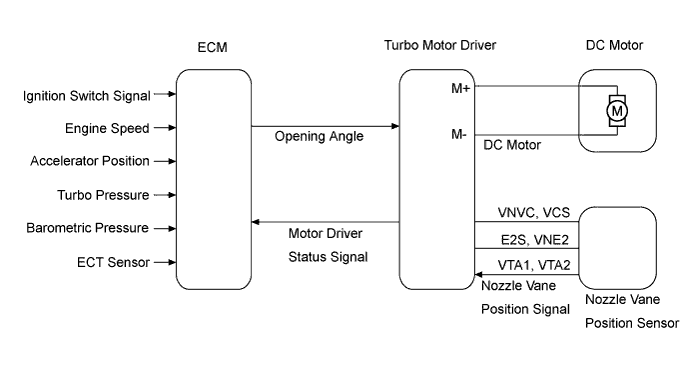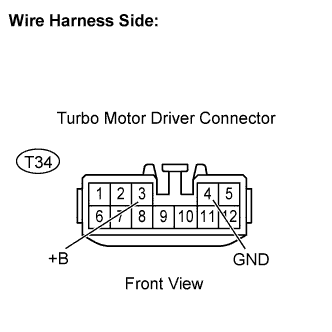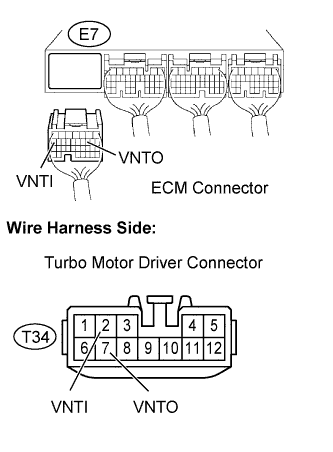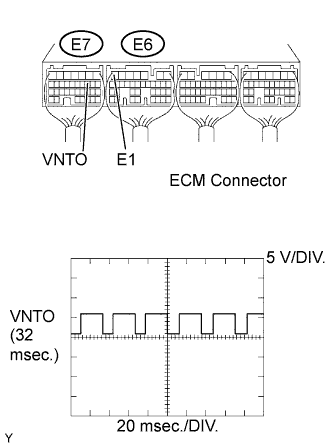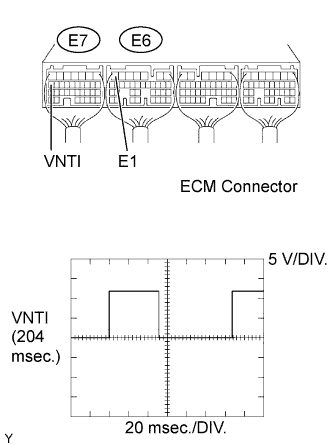Dtc P1264 Vn Turbo Controller Malfunction
DESCRIPTION
WIRING DIAGRAM
INSPECTION PROCEDURE
INSPECT TURBO MOTOR DRIVER
CHECK HARNESS AND CONNECTOR (TURBO MOTOR DRIVER - ECM)
INSPECT ECM (VNTO VOLTAGE)
INSPECT TURBO MOTOR DRIVER (VNTI VOLTAGE)
DTC P1264 VN Turbo Controller Malfunction |
DESCRIPTION
The turbocharger system is comprised of the Variable Nozzle (VN) type turbocharger, the turbo motor driver and ECM.The turbocharger has a nozzle vane which opens and closes to control the volume of the exhaust gas flowing into the turbine. This, in turn, controls the boost pressure. When the nozzle vane moves towards the closing direction, the pressure increases. When the vane moves towards the opening direction, the pressure decreases.The turbocharger actuator built on the turbocharger activates the nozzle vane. The nozzle vane position sensor built on the actuator detects the opening angle of nozzle vane. The turbo motor driver receives an opening angle request from the ECM and a nozzle vane position sensor signal. Based on these signals, the turbo motor driver operates the DC motor and controls the turbocharger's opening angle. The turbo motor driver sends the status as a turbo driver status signal to the ECMThe ECM sends a opening angle request signal to the turbo motor driver to obtain the nozzle vane position for the optimal boost pressure in accordance with the driving conditions.DTC No.
| DTC Detection Condition
| Trouble Area
|
P1264
| When communication error occurs between turbo motor and ECM
(1 trip detection logic)
| - Turbo motor driver
- Open or short in turbo motor driver circuit
- Turbo motor driver ground problem
- ECM
|
WIRING DIAGRAM
INSPECTION PROCEDURE
- NOTICE:
- After replacing the ECM, the new ECM needs registration (Toyota Fortuner RM0000012XK030X.html) and initialization (Toyota Fortuner RM0000012X2005X.html).
- HINT:
- Read freeze frame data using the intelligent tester. Freeze frame data records the engine conditions when a malfunction is detected. When troubleshooting, freeze frame data can help determine if the vehicle was moving or stationary, if the engine was warmed up or not, and other data from the time the malfunction occurred.
| 1.INSPECT TURBO MOTOR DRIVER |
Disconnect the T34 turbo motor driver connector.
Turn the ignition switch ON.
Measure the voltage of the turbo motor driver connector.
- Standard voltage:
Tester Connection
| Specified Condition
|
+B (T34-3) - GND (T34-4)
| 11 to 14 V
|
| | REPAIR OR REPLACE HARNESS OR CONNECTOR |
|
|
| 2.CHECK HARNESS AND CONNECTOR (TURBO MOTOR DRIVER - ECM) |
Disconnect the E7 ECM connector.
Disconnect the T34 turbo motor driver connector.
Measure the resistance of the wire harness side connector.
- Standard resistance (Check for open):
Tester Connection
| Specified Condition
|
VNTO (E7-10) - VNTO (T34-7)
| Below 1 Ω
|
VNTI (E7-17) - VNTI (T34-2)
| Below 1 Ω
|
- Standard resistance (Check for short):
Tester Connection
| Specified Condition
|
VNTO (E7-10) or VNTO (T34-7) - Body ground
| 10 kΩ or higher
|
VNTI (E7-17) or VNTI (T34-2) - Body ground
| 10 kΩ or higher
|
| | REPAIR OR REPLACE HARNESS OR CONNECTOR |
|
|
| 3.INSPECT ECM (VNTO VOLTAGE) |
While idling the engine, check the waveform of the ECM connectors using an oscilloscope.
- Standard voltage:
Tester Connection
| Specified Condition
|
VNTO (E7-10) - E1 (E6-7)
| Correct waveform is as shown
|
| 4.INSPECT TURBO MOTOR DRIVER (VNTI VOLTAGE) |
While idling the engine, check the waveform of the ECM connectors using an oscilloscope.
- Standard voltage:
Tester Connection
| Specified Condition
|
VNTI (E7-17) - E1 (E6-7)
| Correct waveform is as shown
|
| | REPLACE TURBO MOTOR DRIVER |
|
|
